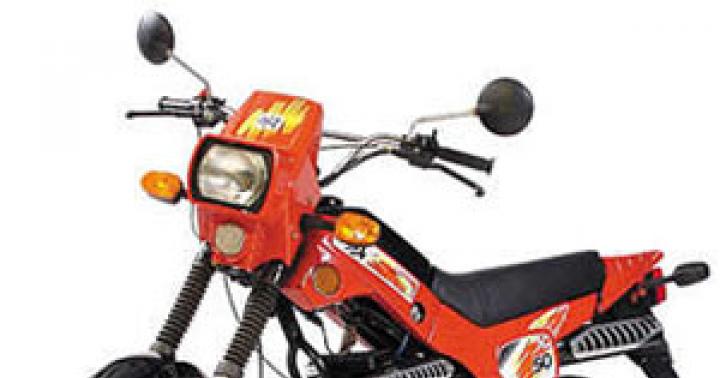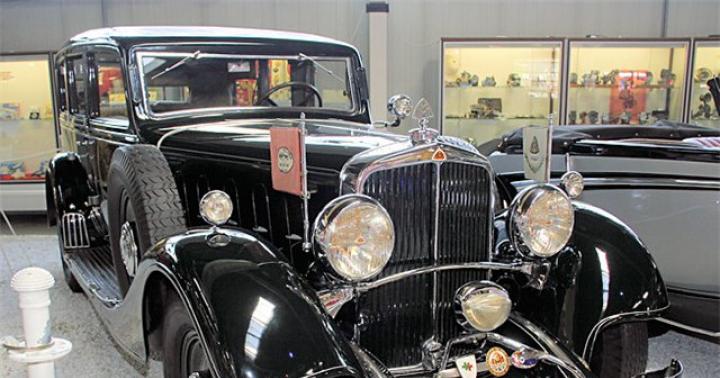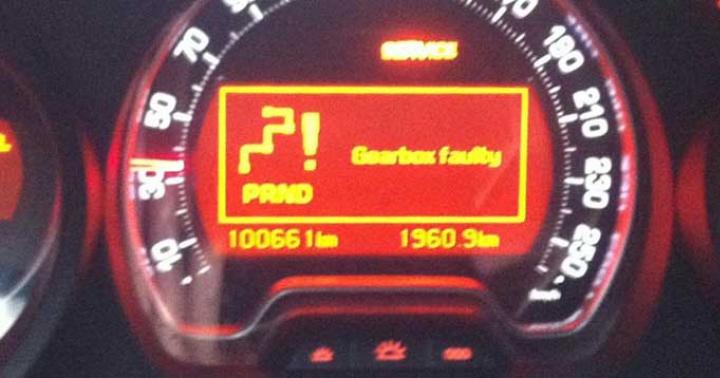If a driver is going to make a left turn maneuver at an intersection where there is also tram traffic, then the first question that should be of interest to him is the presence of a tram behind.
But there is one more thing that needs to be monitored. The presence or absence of a road sign 5.8.1 "Directions I AM movement along the lanes ".
We have specially highlighted the letter " I AM"In the word" directions ", since there are also signs 5.8.7 and 5.8.8, which differ in name and purpose from the sign 5.8.1, and are called" Directions E movement along the lanes ".
Sign 5.8.1 determines the number of lanes at the intersection and the permitted directions of traffic in each of these lanes.
Signs 5.8.7 and 5.8.8 are installed not in front of intersections, but behind them. They inform drivers about the number of lanes in their direction and oncoming traffic. Signs 5.8.7 and 5.8.8 may display prohibitory or prescriptive signs that impose restrictions, conditions or modes of movement on the corresponding lane. That is, between intersections.

So, if at the entrance to the intersection you see the sign 5.8.1, then you should know that you are not allowed to enter the tram tracks in the same direction. The turn must be made from the leftmost lane, making sure that there is no tram behind.

If there is no sign 5.8.1, the turn must be performed from the tram tracks. According to the traffic rules (p. 61, p / p 64.1), if there are tram tracks in the same direction, located on the left at the same level with the carriageway, a turn to the left or a U-turn must be performed from these tracks, if the road signs "Directions of traffic along the lanes", "Direction driving on the lane "no other order of movement is prescribed.
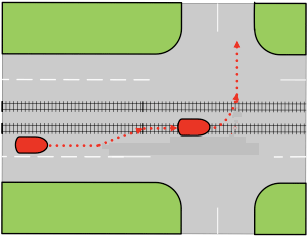
When you saw that there is no sign 5.8.1, you also need to make sure that there is no passing tram behind.
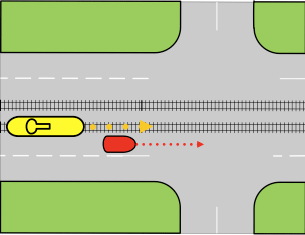
If entering tram tracks creates an obstacle to tram movement, the driver must remain in the occupied lane, without leaving the tram tracks, if the presence of oncoming vehicles does not allow the rails to be released before the tram drives up behind (p / p 64.2 SDA).
No need to go to an intersection to make a U-turn. The U-turn can be done anywhere on the street that is not prohibited.
If there is no sign 5.8.1, and a tram is approaching from behind you, you can advise to reduce the speed of your movement so that the tram passes the intersection, and you still have the opportunity to go onto the rails parallel to them. In parallel with the rails, you need to drive off, so as not to interfere with other cars, move along the left extreme lane.
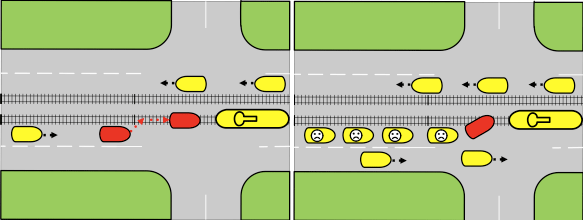
The rules also stipulated the case of creating an obstacle to the movement of the tram (p / p 64.3. SDA). In this case, the Rules say that the tramway should be cleared if possible. And the drivers of vehicles moving side by side in the same direction must provide an opportunity for this.

But in practice, no one does that. If the car has already entered the rails, it can no longer move back, as you can get hit from cars that move in the left extreme lane. These drivers do not see the car standing on the rails in advance, and then do not want to drastically reduce the speed.
It is also very important that if you start to free the rails, the car will be already behind the intersection in a position from which it is inconvenient or impossible to make a left turn. And therefore, in most cases, the driver who has already entered the rails simply stands and waits for the oncoming traffic to end. And the tram is also waiting, heart-rending tinkling with a sound signal.
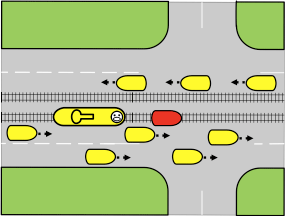
2. To the driver of a car standing on the rails:
Do not twitch or panic because of the tinkling tram behind;
Drive straight ahead along the rails and turn around (usually there is a stop behind the intersection where the tram will stop and lag behind the car);
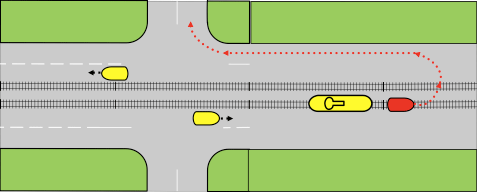
But remember that this is a traffic violation! On the one hand, in doing so, drivers want to do what is best. On the other hand, the traffic police inspector may disagree with your arguments about good intentions.
If there is no oncoming tram, release the passing rails by driving parallel to the oncoming ones.
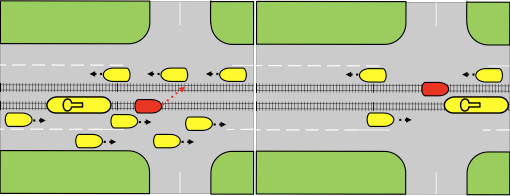
And this is also a violation of traffic rules.
Citing examples when drivers are trying to give way to a tram, deviating from the requirements of traffic rules, we can say that in the current situation drivers really want to do their best and no longer think about traffic rules. After all, our tram is still a “sacred animal”. Like a cow in India. And that is why, realizing that he miscalculated, having left on the rails, the driver begins to worry.
On the part of the traffic police officer, we can say that such attempts to "do the best" at the intersection with tram lines do not bother anyone.
3. The driver driving in the oncoming lane. If you see this situation, slow down, blink a couple of times high beam and allow the oncoming car to clear the way for the tram.

4. The following advice can be given to the driver who is moving along the tram along the way.
If you see that:
There is a car at the crossroads, and a tram is approaching from behind;
The tram is at the crossroads and does not run.
Slow down and drive carefully to the intersection. What if you need to let someone go off the rails !?
And you can prudently rebuild to the right, so as not to stop yourself and give the other driver the opportunity to go off the rails.

People says
Čao! 02/04/2010 at 22:56 writes
Rarely do I make a left turn in the above scenario (via tram tracks), but an excellent article for the future! I just don’t know whom to thank ... Already which article is published without the author's indication. :(
P.S. And please return the "remember me" button! I already got tired of typing login / password every time.
Dmitry Bolashev on 02/05/2010 at 08:51 writes
All materials from the "Master-class" belong to the pen of Yuri Krasnov. "Remember" was returned.
02/05/2010 at 22:10 writes
Thanks! The article is clear! Useless for me only. All these "algorithms" of behavior were taught during his official training at a driving school. Glory to such instructors as I had!
Lena 02/06/2010 at 19:48 writes
You read and read, you think how smart I am now, and every time it turns out that you are digging up something new. Next to the tram tracks at first I drove absolutely calmly (thanks to the people who reconstructed them), because. I didn't see a single tram in my eyes, but the first time I saw it, I was even a little confused, especially when they jink disgustingly: (Now I will bear in mind that the devil, ugh, the tram is not so scary as they are afraid :)
iks 03/16/2010 at 21:46 writes
The article is necessary, but there are a few comments
1) an educational program about the signs "direction of movement along the lanes" is a necessary thing, but it should occupy the attention of the audience, especially when these signs never have any relation to the issue in question ... what's the point?
2) advice to pass the intersection on the tram track or "in parallel" to enter the oncoming tram lane grossly contradict the traffic rules
in my opinion, it's better to let the tram "tinkle" than the driver will commit such a madhouse
after all, without knowing the root cause, such a maneuver will catch the eye of many other drivers. and who knows how many have the thought "and what, is it already possible?" will grow into a guide to action
3) and one of the most insidious omissions.
it was imperative to give advice "when turning left from tram tracks, be very careful: a car located to your right on the extreme left lane can simultaneously with you or even a little earlier start a U-turn that is legal for yourself (according to the current traffic rules) ..."

Yuri Krasnov 17.03.2010 at 10:24 writes
Thanks for the comments.
According to item 1
About the sign "direction of movement along the lanes" was mentioned precisely because some drivers, seeing such a sign between intersections, think that it is valid at the intersection.
According to item 2
The expression "gross violation of traffic rules" was invented by the traffic police in order to scare the drivers with this expression and write them heavy fines. Even if it is possible to recognize the violation as gross, it is only if as a result of the violation an emergency situation was created or an accident happened.
Any driver who knows the traffic rules, having seen a maneuver that contradicts the Rules, understands that this cannot be done, but in this situation another driver decided to do so.
While driving, drivers see a lot of traffic violations around them, but they do not start to behave like this en masse. Since everyone (well, or many) understands that in this situation the driver had no choice or he wanted the best.
This article gives advice on how the driver can “settle” a conflict situation with a tram in real conditions. The traffic rules say that the driver must be allowed to derail if he interferes with the tram. But who does that? But this is also a violation of traffic rules.
Of course, I agree with you that in addition to describing the possible actions of drivers that they take in such "inconvenient" situations, it was necessary to point out that this is a traffic violation. And I will definitely make adjustments.
According to item 3
A very important remark. I will add to the article.
iks 03/17/2010 at 15:10 writes
once again I want to thank for this and other materials - the most important thing in them is that an attempt has been made to invite drivers to think not only about themselves, but about traffic situation in general and other drivers
In those places where it is advised to do this or that with a deviation from traffic rules, it is imperative to mention this, as well as to talk about increased attentiveness (after all, other drivers do not expect violations, and in turn, they can also plan something like that
moreover, focusing on the fact that, yes, this is a violation, but when there is a traffic jam or a difficult situation, it is not possible to comply with the traffic rules, and sometimes you have to deviate from certain traffic rules requirements to clear the traffic situation
Zinuka on 05.12.2012 at 06:41 writes
3) and one of the most insidious omissions.
it was imperative to give advice "when turning left from tram tracks, be very careful: a car located to your right on the extreme left lane can simultaneously with you or even a little earlier start a U-turn that is legal for yourself (according to the current traffic rules) ..."
I didn’t understand, so about the U-turn from the extreme left, shouldn’t it be done from the tracks too?

Yuri Krasnov 05.12.2012 at 09:01 writes
Everything is correct.
If there are tram tracks in the same direction, located on the left at the same level with the carriageway, a left turn or a U-turn must be performed from these tracks, unless a different traffic order is prescribed by the road signs "Directions of traffic along the lanes", "Direction of movement along the lane".
The article was simply written when it was possible to perform a maneuver both from the tram tracks and from the left extreme lane.
Then the traffic rules changed and the article changed, but the old comments remained (you can't remove them)
Zinuka 12/06/2012 at 08:30 writes
Thanks. tomorrow is an exam, I'm terribly afraid.

Yuri Krasnov 06.12.2012 at 09:57 writes
Break a leg
vlsext 04/17/2010 at 12:35 pm writes
[We advise the tram driver not to tink heart-rendingly. Anyway, the car won't go off the rails any faster.]
Let it tink when some arrogant or cunning drivers crawl onto the rails shortly before the tram - they may not want to next time, if this time it became uncomfortable.
I often observed: two or three or four drivers do not climb on the rails, because they see a tram from behind about 100-300 meters. And behind them some - do not want to stand and wait - leave on the rails shortly from the tram, drive up to the intersection on a par with the others. And such 2-3 cars - a bad example - are contagious. A tram approaches, the green light turns on, but the oncoming flow does not allow to turn left. Sometimes the first track from the tramway has time to slip through, as a rule, interfering with the oncoming ones (the rails are slippery, especially in the rain).
Well, how can you let these drivers go off the rails? For their sake, abandon the left turn and go straight? This is excessive altruism - and not at all good for everyone. You get away with this, there is no educational work, the rest - at another intersection you will interfere, you turned now - avoided getting into an accident that happened at the next intersection ... Let the tram tinkle like that - maybe they will think another time.
It's another matter if the tram was really not far away at once, it became as it should be, and then it turned out that the oncoming people did not allow it to pass (they flew to yellow and even red, one or two cars out of three or four, for example, managed to get through). Here, yes, it’s not a sin to help, if anything, and even roll further to the U-turn, IMHO. It's easy to recognize: they are standing there when you drive up to the intersection, and not behind you they were re-lined up there shortly in front of the tram.
adolfus 09/22/2011 at 17:14 writes
If there is no sign 5.8.1, the turn can be performed both from the left extreme lane and from tram tracks. According to the traffic rules (p. 61, p / p 64.1), if there are tram tracks in the same direction, located on the left at the same level with the carriageway, a turn to the left or a U-turn can be performed from these tracks, if the road signs “Directions of traffic along the lanes”, “Direction driving on the lane "no other order of movement is prescribed.
Vraki. The rules changed in 2011. And the turn MUST ONLY be done from tram tracks.
64 If there are tram lines in the same direction, located on the left at the same level with the carriageway:
64.1 a turn to the left or a U-turn must be performed from these paths, unless a different traffic order is prescribed by the road signs "Direction of movement along the lanes", "Direction of movement along the lane";
Anax 09/25/2011 at 01:36 writes
Judging by the date of the first comment, the article was written a year and a half ago - then it was exactly as in the text. But in general you are right, you need to make edits to the text.

Yuri Krasnov 26.09.2011 at 15:39 writes
Yes Yes. I have to make it.
Lola on 10/29/2011 at 20:19 writes
So now I have to travel on the roads where trams run ...
I used to be afraid of them. Now my favorite streets are Masherova and Kozlova!
Before starting to ride there every day, I read the rules to remember ...
But I realized that most do not even know how to properly drive on such roads.
It can be uncomfortable when you turn left from tram lines. Constantly thinking about this tram, which can drive up from behind.
And when you stop in front of the tram stop, when the tram is on an emergency light and pedestrians are walking, other drivers who are behind you start honking you - "Like, go through! What are you standing for ?!"
And how do pedestrians who see a tram in the distance behave, BUT are already running to the stop, confident that drivers of other cars should let them pass. Themselves rudely break the rules. A tram drove up, turned on the emergency light and opened the doors - go pedestrians! ... But pedestrians, I'm sure, do not know these rules.
svae 10/31/2011 at 12:48 pm writes
lola should be kinder to people. You are of course the smartest, but you are not the last fools around either.
Lola 11/01/2011 at 09:41 writes
svae, and you probably are the same unruly pedestrian?
At the expense of "smart" (or "NOT smart") - not for you to judge. Your bias is illogical.
svae 11/01/2011 at 10:12 writes
Mark 17.09.2012 at 17:14 writes
Hello, please tell me, what if not an intersection, but just a road with several lanes in both directions in the middle of the tram track, and there is a limited area where you need to turn around, there are no turns, you can simply change the direction of travel, i.e. turn around. Should the tram cross the track closer to the side in which we are going to go, or as in the pictures in cases of turning? I hope I asked the question clearly, thanks.

Yuri Krasnov 17.09.2012 at 20:49 writes
As I understand it, the question is about how to turn around outside the intersection on the road with tram tracks in the middle?
If there is no tram behind, we leave on the tram tracks parallel to them, making way for oncoming cars and the tram, and turn around.
diman73rus 03.10.2012 at 09:18 writes
Hello! And how should you turn left if the tram lines at the intersection also turn left? here: https://maps.yandex.ru/-/CVqNqV0~ and here: https://maps.yandex.ru/-/CVqNq6Kr

Yuri Krasnov 03.10.2012 at 16:31 writes
Both of these examples are a bend in a road where another road adjoins at the bend. Therefore, there is no left turn, but there is movement along a bend in the road - which means we simply move along the rails in our own lane.
diman73rus 03.10.2012 at 18:16 writes
there is no bend. there is also a road to the right.

Yuri Krasnov 03.10.2012 at 23:14 writes
I looked at the photos. There, in both cases, at a bend in the road, there is an intersection with an adjacent road on the right. And drivers who are moving along this road can make a right turn on this adjacent road, or left if they are moving from a different direction. If to the left, then before the turn (in the absence of the sign "5.8.1 Directions of movement along the lanes") must go onto the rails.
Reggy 01/10/2013 at 12:19 writes
I have a question of how to determine when it is possible to enter the tram tracks, I mean from what place

Yuri Krasnov 10.01.2013 at 14:38 writes
If there is no sign 5.8.1 "Direction of movement along the lane" or 5.8.2 "Direction of movement along the lane" in front of the intersection, then the driver enters the intersection on passing rails. It doesn't matter how early you get on the rails. But, of course, not three kilometers away. Usually they leave about 20 meters before the intersection.
The following things matter here:
1. Changing lanes on rails at an acute angle, and for such a maneuver you need more space.
2. Driving onto the rails is not always pleasant for the suspension. You will not rebuild at speed. And you go down just before the intersection. It turns out that when you are down, then you leave.
Mark 03/05/2013 at 14:30 writes
Please tell me when I and oncoming cars are simultaneously turning left on the road with tram lines, which sides do we drive on as at a regular intersection or as on a boulevard.

Yuri Krasnov 03/05/2013 at 16:10 writes
If you mean an ordinary intersection, where the intersection of two roads, then you drive off with an oncoming car on the right side.
The only nuance is that if there is a sign "Directions of movement along the lanes" - the turn is carried out from the left extreme lane, and if there is no such sign - you need to go onto the rails before the turn (if there is no tram).
libertina 03/07/2013 at 14:53 writes
Good day! Today the following situation arose. I am driving along Y. Kolas, I want to turn left. Before the intersection sign 5.8.1 (from the extreme right straight ahead and to the right, from the extreme left only straight ahead). There is no prescriptive sign straight and to the right. There is no passing tram either. I enter the tram lines and wait for the oncoming tram and oncoming cars to pass. And then a car appears behind me, gives a continuous sound signal and is going to go straight !! He sees that I’m not moving from a place, bypasses me to the left (on oncoming tram tracks !!!), stops and blocks my left turn! Apparently a teacher. I just can't understand what they wanted to teach me. If I'm wrong in this situation, explain to me what. Please.

Yuri Krasnov 03/07/2013 at 18:06 writes
If you travel there often I can give this advice. Go straight through the intersection, immediately after the intersection, get onto the rails (if there is no tram behind), if there is a tram

Yuri Krasnov 03/07/2013 at 18:10 writes
If a sign 5.8.1 "Directions of traffic in lanes" is installed in front of the intersection, then the prescriptive sign is not needed, since 5.8.1 indicates the number of traffic lanes at the intersection and the permitted directions of traffic in each of them.
That is, in the case you described, you could not make a left turn at this intersection - you could only move straight from the left lane.
You obviously thought that if you get on the rails, then you will not interfere with those who are going straight? But I want to remind you that if there is a sign 5.8.1 in front of the intersection, which allows turning left from the left extreme lane, then driving onto the rails is prohibited (subparagraph 64.1 of paragraph 64., Chapter 9. "Maneuvering" of the traffic rules).
If you travel there often I can give this advice. Go straight through the intersection, immediately after the intersection, go onto the rails (if there is no tram behind), if there is a tram, wait until it passes and again exit onto the rails, turn around and turn right onto the street you need.
Good luck with the upcoming holiday on March 8!
And oncoming drivers of oncoming cars fulfill the requirement of subparagraph 65.1. when turning left, the vehicle must move as close as possible to the center of the intersection, unless road signs (horizontal road markings) prescribe a different order of movement, while the oncoming vehicle turning left must be on the right.
And taking into account the fact (as I understand it) that it is not possible to leave the tram lines before leaving the intersection, signs 5.8.1 "Directions of traffic along the lanes" should be installed in front of the intersection. Otherwise, if there are no such signs, then drivers are obliged to get on the rails before turning left. I would like to know about the presence of such signs and about the possibility of getting on the rails before the turn ???
Voldemar 07/22/2014 at 15:47 writes
Good day, we have two signs in front of the crossroads in the city of Tver 5.8.2 Directions of traffic on the lane straight - to the left and straight - to the right. At the same time, there are tram tracks along which everyone turns to the left in unison. Recently they hung up a bunch of cameras and sent letters of happiness to the people. Enlighten, do these signs act like 5.8.1 or can you turn left from tram tracks?
Natalya2011 08/12/2014 at 10:18 writes
Good day! Could you please clarify one point in your article. I did not understand a little why the situation is considered a violation of traffic rules when you interfere with the passage of the tram and drive along the paths in the same direction to the nearest tram stop and make a maneuver there. (It is clear that it is impossible to interfere with the tram, this, in fact, is a violation, but I'm interested in exactly why it breaks the rules to get to the tram stop and turn around after it road traffic). After all, driving on tram tracks in the same direction, if they are on the left and on the same level with the road, and there are no prohibition signs and markings and the rest of the lanes are occupied, is allowed. Naturally, since it is problematic for the car to return to the right, it means that the rest of the lanes are occupied, as well as the other conditions for passing traffic on the tram tracks are met.
thanks for the answer

Yuri Krasnov 08/12/2014 at 13:05 writes
This is because the traffic rules of the Republic of Belarus prohibit movement on tram lines of the same direction at marked and regulated intersections (paragraph 81, Chapter 10). That is, it is possible to move on rails only between intersections that are indicated by priority signs or regulated ones.
Pupkin 02/21/2015 at 18:28 writes
Good afternoon. I would like to ask a question to the author of the article.
Consider an intersection as in the picture that immediately follows the picture of signs 5.8.7 and 5.8.8
Everything is exactly as in this figure, only the sign 5.8.1, the directions are indicated from two lanes only straight ahead.
Question: is it possible to turn left from the tram tracks?
Indeed, in this case, the sign determines movement along the lanes - and the tram lane is not affected by the sign, can the sign be interpreted as allowing a left turn only from tram tracks and prohibiting a left turn from the left lane of the sign?
If this is not the case Why is there no prescriptive sign 4.1.1 Straight ahead? Thanks.
The author drew the diagram in such detail that there was only one conclusion, he knew for sure that the reversal was prohibited. And now (if not a supporter of those: - "who runs into the bushes and whirls") is trying to figure it out according to the law.
In my opinion, varang is right.
And in general it is necessary (according to the American principle, they have not all the worst), where the U-turn is prohibited, the stripes should be separated by concrete bumpers, and not by a white stripe, maybe there will be fewer questions, and most importantly there will be accidents.No, your conclusion is wrong. I did not know that a U-turn was prohibited there in the very conditions that were at that moment. I heard that traffic police do not approve of a U-turn on tram tracks, but I connected this with the fact that there last summer drew a continuous line between the tram lines and the 3rd lane. In this situation, the solid (or rather its remnants) were under the snow-ice, I decided that if anything, I would hang out. But they started to solder the oncoming lane there.
Because I violate very rarely (I don't remember turning around on tram tracks) and have never been in such a situation yet --- but I have never encountered a reversal ban on 4 or more lanes. And if they stopped him, he did not argue, aggravate the situation. Simply, when I was released, it became very interesting how legitimate the actions of the traffic police officers were, tk. no further than last year I re-read the traffic rules from 2006 (I refreshed the knowledge obtained in my memory 10 years ago), but I did not remember such an item at that moment, and upon returning home I took it out and began to re-read it again.
2 B () rI $
As for the number of lanes --- I wrote "the second lane is functioning in half with grief" --- I meant a snowdrift track on which buses trolleybuses travel, passenger cars- it is difficult to move, especially at a speed of more than 30 km / h, because begins to throw ... But still she was.2 Vozhd
In the picture there are 6 lanes, if you believe the markings at traffic lights, there are also 6 lanes, but in fact there were still only 4 lanes that day.Wait, I found the Resolution of the Plenum The Supreme Court Russian Federation N 18 of October 24, 2006 --- A "cool" resolution with explanations was struck by DPSniki ...
PS: To be honest, humanly speaking --- I do not agree with the fact that rights should be taken away when turning on tram lines. If I do not interfere, not only with a tram, even with passing and oncoming cars, this is the insanity of our judicial reality. All the same, delusional laws sometimes situations arise. Something like the prohibition of overtaking vehicles moving at a speed of more than 1 km / h, etc.
OK. Figs with them. Now I'll know.
PS2: Now I have re-read clause 12a again (on two-way roads with four lanes or more, it is forbidden to go to overtake, turn, turn on the side of the road intended for oncoming traffic (clause 9.2 of the SDA). Such a prohibition must be indicated by road markings 1.3;) - it does not stipulate the presence of tram lines in the middle of these four lanes or more. However, judging by this point --- yes, a violation.
But about tram tracks is clearly stipulated in paragraph 12d (It is forbidden to enter the tramway tracks of the opposite direction. However, it is allowed to move along the tramway tracks of the opposite direction, located on the left on the same level with the carriageway, when all lanes of this direction are occupied, as well as when bypassing, overtaking, turning left or making a U-turn, taking into account clause 8.5 of the SDA if this does not interfere with the tram (clause 9.6 of the SDA).)
Which again begs the question, to which point should my reversal be attributed? To clause 12a or clause 12d?
And four lanes in clause 12a --- for each direction, or for the entire carriageway? Somewhere it is stipulated for "each direction" (as in the conclusion of the 12th point), somewhere not.
Driving on tram lines often raises questions from drivers. If the car owner has gaps in his knowledge of the rules of the road, he can easily get a fine, but it will be much worse to get into an accident or become the culprit. Let us discuss in what cases and how it is possible to make a U-turn and a left turn on the rails.
When is tramway traffic prohibited?
There are situations where drivers are allowed to drive on the rails. This is possible if the tracks are located to the left of the intended trajectory of roadless vehicles and are level with the carriageway, and also go in the same direction. You can only drive along the passing rails when the lanes are busy.
Thus, there are cases in which the movement on rails intended for trams will be illegal:
- Drivers are not allowed to follow the tracks if they are located to the right of the carriageway. Oddly enough, but in many large cities this situation is common.
- If the rails rise above the road or are located below it (for example, on a lawn), then they belong to the median strip, the movement along which is unacceptable according to traffic rules.
- It is prohibited to drive onto the rails intended for the opposite direction. Such an action is equivalent to driving into an oncoming lane and threatens with confiscation of rights.
Important: it should be understood that if you want to get on the rails, you need to pay attention not only to their direction, position relative to the road and the level in relation to it, but also to the presence of road signs and markings. Some signs, as well as a solid one drawn along the paths, prohibit movement along them.
Is it possible to turn around on tram tracks?
The need to turn around with the departure on the rails every day arises for many drivers. But does everyone understand how to properly perform such an action? Of course, ignorance of traffic rules in the field of movement of rail vehicles does not relieve anyone of responsibility. Statistics say that only a fifth of car owners are well aware of the sequence of making a U-turn through tram tracks. It is allowed under certain circumstances. The cases in which it is necessary to turn around with the exit onto the rails will be discussed below.
Important: any maneuver to be carried out using tramways must be safe. Therefore, motorists need to be careful - you must not interfere with other road users. Make sure the tram is out of sight.
Turning off tram tracks
Sometimes turning off the tram lines is not just allowed, but is considered the only legal action for the driver. There are other options that involve ignoring the presence of a rail when performing a maneuver. Consider different situations and decide on the procedure that motorists need to know.
Turn left from tram tracks
Of course, the main question is not even whether it is legal to use tram lines? Of course, yes, you need to go. The technique of performing the turn will be essential here. It is logical that the maneuver can be carried out by choosing one of two methods.
The first way
Change lanes on the tracks intended for trams going in the same direction, make sure there are no obstacles. Then make a left turn from the tram tracks, and the oncoming lane rails should be crossed at right angles to the carriageway. Consider Figure 1.
The driver must turn in the direction of the green arrow, as there are no signs or markings indicating a different course of action. In the traffic rules (clause 8.5) it is said that turning to the left should be carried out from the extreme left position, and in this case it will be passing tram tracks.
Second way
The same paragraph 8.5 of the SDA states that it is impossible to turn off the rail if certain signs are installed or there are special road markings that do not allow maneuver (Figure 2).

When signs or markings are prescribed to move along the lanes, turning to the left from the tramway tracks in the same direction is strictly prohibited. Refer to Figure 3.

We see a sign informing drivers about the need to move along the lanes, therefore, you can turn left only from the left lane, that is, along the green trajectory, changing lanes on the rails before the maneuver is unacceptable.
Important: when turning left, make sure that the car moves perpendicular to oncoming tram lines. Otherwise, the traffic police have the right to regard such a maneuver as driving into an oncoming lane.
Turn right from tram tracks
Traditionally, the rails are in the middle of the carriageway, and when turning right according to traffic rules, the car must take the extreme position in right lane... Thus, when turning to the right, drivers cannot and should not end up on the rails. Moreover, the traffic rules say that movement on the rails to the right of the carriageway is not allowed.
Of course, many are interested in the question - why tram tracks are built exactly in the center of the road. In fact, this is done to ensure the safety of both cars and pedestrians. Imagine a situation where trams would move to the side of the roadway. Then they would dock with many exits from courtyard areas, and the likelihood of a sudden appearance of a pedestrian would be extremely high. Moving in the center allows the driver of a rail vehicle to soberly assess the situation and minimize the risk of an accident.
U-turn on tram tracks
If there are trams in your city, it means that sooner or later the need to turn around through the tram lines will arise. Previously, the sequence of actions that must be followed when turning to the left was considered. Any car owner understands that in most situations, the rules for making a U-turn are similar. And remember to drive over the rails at a 90 degree angle.
You can turn around both at the crossroads and outside of its borders. Let's talk about these two situations.
U-turn on tram lines outside the intersection
As a rule, drivers are intimidated by such a prospect, although there will be no difficulties if you remember the traffic rules. If you need to make a U-turn on tram lines outside of an intersection, look carefully at the signs. When they are not there, as there is no forbidding road markings, you should rebuild onto the passing rails and turn around. The presence of signs indicating movement along lanes, or similar markings, leaves motorists with only one legal opportunity - to make a U-turn, having previously taken the extreme left position in the corresponding lane.
U-turn on tram lines at an intersection
It is performed in the same way as turning to the left. The tram usually has an advantage over trackless vehicles, the exception is the intersection of unequal roads, and the tram must travel on a secondary road. Therefore, if you are approaching an intersection on the main road, and the tram is on a secondary road (there is a sign “Give way” in the direction of its movement), then you will have priority. That is, in this case, you do not need to let the tram pass, you can turn around. In other situations, the rail vehicle must be skipped.
Fines for violations of the rules of travel and U-turn on tram tracks
The penalties for neglecting traffic rules in the area of the considered maneuvers are as follows:
- Ignoring road markings or signs threatens with a monetary penalty of 1000-1500 rubles.
- If the car owner, when performing the maneuver, was not convinced of the absence of a passing tram in the visibility zone and created a hindrance to him, then he risks parting with 500 rubles. If you do not miss the tram with the advantage at the intersection, the fine will be 1000 rubles.
- If the driver is driving on rails in the opposite direction, this is a serious offense, which may be followed by forfeiture of rights or a fine of 5,000 rubles. Under extenuating circumstances, for example, if you had to drive into the oncoming lane, as an obstacle was found on the road, the fines will amount to 1000-1500 rubles.
Important: remember that deprivation of rights can only occur by a court order. If, for example, you have entered oncoming tram tracks, which was recorded by a traffic police officer, in most cases you will have a confiscation of rights. But sometimes driving a car is not just a hobby for a person, but a job. Then it is best to seek advice from, perhaps, he will help you keep your driver's license.
Save the article in 2 clicks:
In most cases, rail vehicles have priority over cars, but even when the tram does not go according to the rules, it is better to skip it, because otherwise the consequences can become very unpleasant for you. Car enthusiasts should remember that the mass of a tram is ten times greater than that of a car. And the adhesion of metal wheels and rails is much worse than that of asphalt and car tires. Therefore, you should not go to roads with tram lines without knowing the rules of the road.
